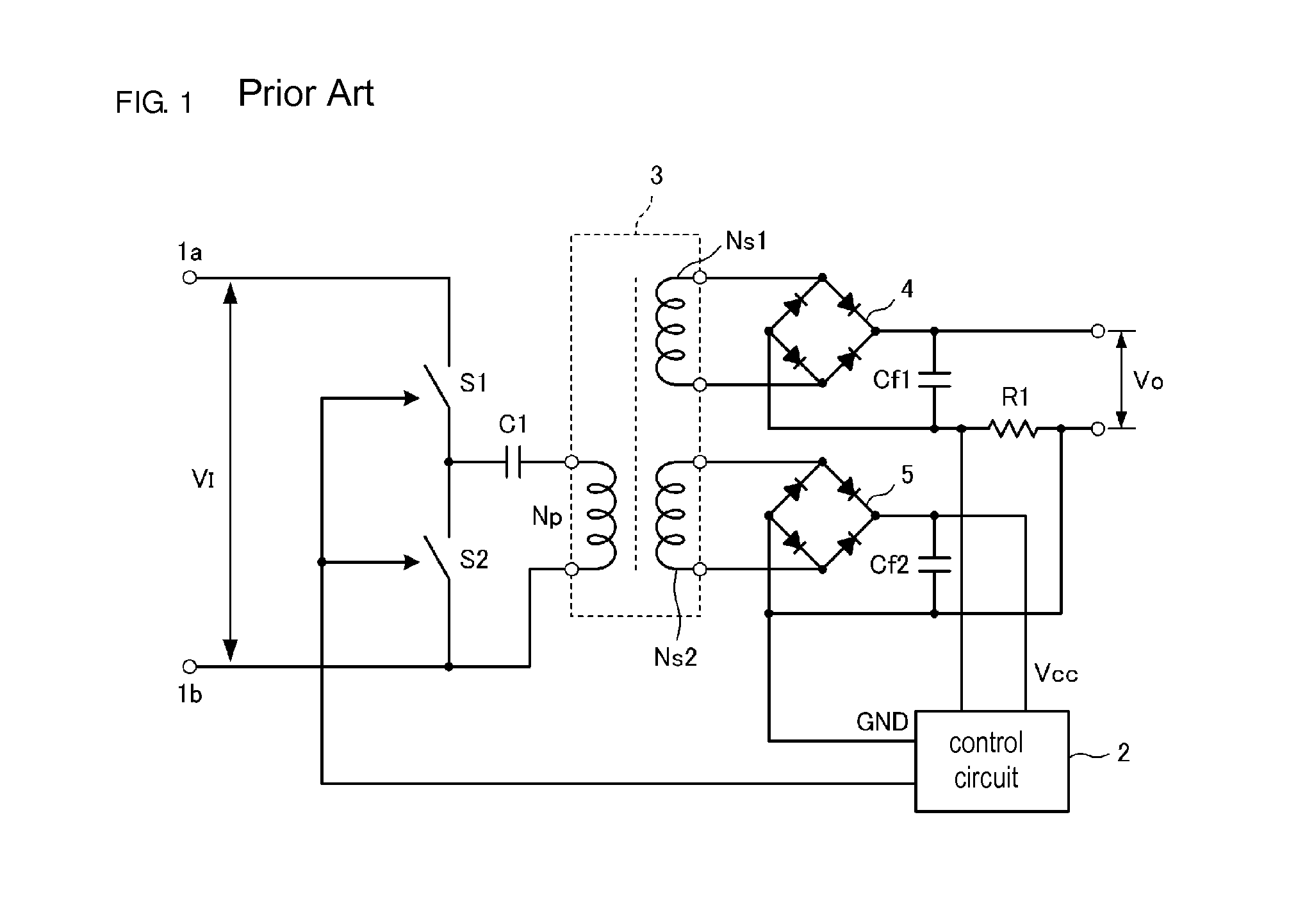Switching power supply apparatus
a power supply and power supply technology, applied in the direction of electric variable regulation, process and machine control, instruments, etc., can solve the problems of low accuracy of non-control output voltage stabilization, output difference between two outputs, and difficulty in high-quality output voltage output, so as to increase the controllable load range, keep the accuracy of respective output voltages high, and maintain the effect of accuracy
- Summary
- Abstract
- Description
- Claims
- Application Information
AI Technical Summary
Benefits of technology
Problems solved by technology
Method used
Image
Examples
first preferred embodiment
[0035]A switching power supply apparatus according to a first preferred embodiment of the present invention will be described below with reference to FIGS. 2 to 8.
[0036]FIG. 2 is a circuit diagram of a switching power supply apparatus 101 according to the first preferred embodiment. The switching power supply apparatus 101 includes a transformer T1 in which a primary winding L1 is magnetically coupled to a first secondary winding L21 and a second secondary winding L22. A first switching element Q11 and a second switching element Q12 are connected in series between power supply input terminals Pi(+) and Pi(−) both constituting a power supply input portion to which a DC input voltage Vi is input. Between the primary winding L1 of the transformer T1 and the second switching element Q12, a resonant capacitor Cr and an inductor Lr are connected in series to constitute a serial resonance circuit in cooperation with the primary winding L1. The inductor Lr may be constituted in the composit...
second preferred embodiment
[0086]FIGS. 9A and 9B are circuit diagrams of switching power supply apparatuses 103A and 103B according to a second preferred embodiment of the present invention. The circuit diagram of the second preferred embodiment differs from that of the first preferred embodiment, illustrated in FIG. 2, in the configuration on the secondary side of the transformer T1. The operation of the converter is the same as that in the switching power supply apparatus 101 illustrated in FIG. 2.
[0087]In examples of FIG. 9A, the first secondary winding L21 and the second secondary winding L22 are wound independently of each other, and the grounded side of the first rectifying and smoothing circuit is connected to the voltage output side of the second rectifying and smoothing circuit
[0088]With such a configuration, sharing between the first secondary winding L21 and the second secondary winding L22 is adjusted in supplying electric power. For example, in the case of needing the outputs of Vo1=12 [V], 100 [...
third preferred embodiment
[0092]While each of the above-described preferred embodiments preferably includes a transformer including two secondary windings, a third preferred embodiment includes one secondary winding to provide two output voltages. FIGS. 10 to 13 are circuit diagrams on the secondary side of four switching power supply circuits according to the third preferred embodiment. The configuration on the primary side may be any of the circuits described in the foregoing preferred embodiments.
[0093]In an example of FIG. 10, a voltage doubler rectifier circuit including the rectifier switching elements Q21 and Q22 and the capacitors Co1 and Co2 is associated with a secondary winding L2 of the transformer. During a period in which a positive voltage is generated in the secondary winding L2 on the side denoted by a dot mark, the capacitor Co1 is charged through a path denoted by a solid-line arrow in FIG. 10. During a period in which a negative voltage is generated in the secondary winding L2 on the side...
PUM
 Login to View More
Login to View More Abstract
Description
Claims
Application Information
 Login to View More
Login to View More - R&D
- Intellectual Property
- Life Sciences
- Materials
- Tech Scout
- Unparalleled Data Quality
- Higher Quality Content
- 60% Fewer Hallucinations
Browse by: Latest US Patents, China's latest patents, Technical Efficacy Thesaurus, Application Domain, Technology Topic, Popular Technical Reports.
© 2025 PatSnap. All rights reserved.Legal|Privacy policy|Modern Slavery Act Transparency Statement|Sitemap|About US| Contact US: help@patsnap.com



